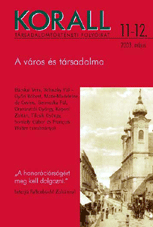„A város a láz, a nyugtalanság, a munka és a fejlődés”. Magyarország városhálózata a 20. század elején
The urban System of Hungary in the Begining of the 20th Century
Author(s): Róbert Győri, Pál BeluszkySubject(s): History
Published by: KORALL Társadalomtörténeti Egyesület
Keywords: social history; urban history; Hungary; 20th century; urban functions; concept of town; settlement structure; statistics; town hierarchy
Summary/Abstract: The authors present the Hungarian town hierarchy of the first few years of the 20th century by relying on empirical methods (by drawing on the existence or the lack of 88 urban establishments sorted by settlements). In 425 (by more rigorous criteria 332) cases urban establishments achieved such a concentration that allows these settlements to be classified as towns. However, only 139 settlements possessed municipal rights (conversely, this research could not identify urban functions in all of them), so that the examination of the Hungarian urban stock, urban development and urbanization cannot be restricted to settlements with municipal rights. While 20,4% of the country’s inhabitants lived in settlements with municipal rights in 1910, 29,2% lived in such that had urban functions. In Hungary, the central role that some towns played in the regional administration (county centres and chief towns of the district) vastly affected the evolution of town hierarchy. The era of the middle class did not replace the core of the urban stock but initiated the transformation of towns of higher hierarchical ranks, and the substitution of their local society and functions. Until 1910, modern industry only elevated 5–7 settlements to the rank of the town. Within the Carpathian basin significant differences were manifest between the urban structure of the Alföld towns and towns of the other regions, since on the Alföld, urban functions settled in dense but agrarian population concentrations, so that their „specific values” were low and for this reason their identity as towns is debated. The quantity of urban functions they served however, were not disadvantaged compared to towns of other regions of the country.
Journal: Korall - Társadalomtörténeti folyóirat
- Issue Year: 2003
- Issue No: 11-12
- Page Range: 199-238
- Page Count: 40
- Language: Hungarian

